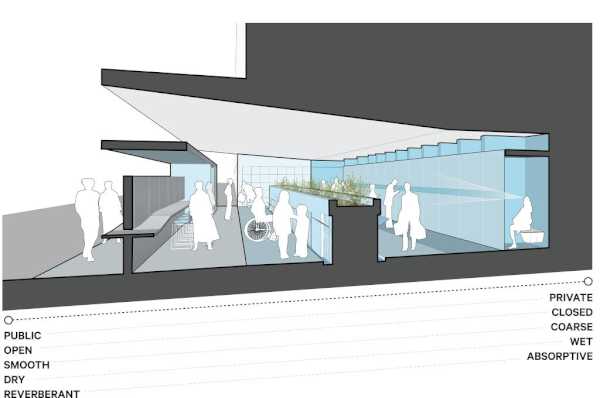Reinventing the restroom to end the transgender bathroom debate
/arc-anglerfish-arc2-prod-pmn.s3.amazonaws.com/public/ADZWQ5OH2RH2NO4FIDZ3BHBPMU.jpg)
New York architect Joel Sanders is known for designing ultra-refined, high-end apartments (including a swanky Philadelphia penthouse) and university study centers that resemble luxury crash pads (like the University of Pennsylvania Education Commons). But he also is interested in the intersection of public space, the body politic, and the politicized body.
After North Carolina passed a bill last year barring transgender people from using bathrooms that do not match the sex on their birth certificates, he began wondering whether the tensions over the issue could be overcome with design. Working with Susan Stryker, a gender studies professor at the University of Arizona, and lawyer Terry Kogan, Sanders launched a project called "Stalled," which aims to reinvent the restroom as we know it. The goal is to design a universal restroom where all people -- straight, gay, trans, disabled -- can feel comfortable and safe.
After Sanders' lecture last week at PennDesign, he expanded on his ideas in a telephone interview.
What got you interested in designing public restrooms?
I'm interested in bathrooms, and have been for the past 20 years, because they exemplify the way in which everyday common spaces reflect our cultural values. The bathroom is where social, political, psychological, technological, and legal forces all converge. Bathrooms tend to be the most expensive room per square foot, yet we tend to take them for granted. The bathroom is just one way designed environments shape how the body interacts with space, yet architects often forget that what we're supposed to be designing for the human body. It's perhaps the most intimate architectural space we inhabit.
The so-called bathroom debate is now the front line in the culture wars. Why are they so polarizing?
After the Houston mayor introduced nondiscrimination legislation in that city, it was defeated by conservatives who played on unsubstantiated fears that transwomen were really men in dresses who would prey on women and girls in restrooms. Supporters of the legislation would cite statistics showing the real people at risk are the transwomen, particularly transwomen of color. While bathroom safety is a real concern, Susan and I feel that what was being said was masks deep-seated, culturally ingrained anxieties about women, gay people, the disabled.
You argue that the solution isn't so much cultural as spatial and architectural. Can you explain?
In all the legal battles, there is always an assumption that there has to be a binary distinction -- a men's and women's room. Terry Kogan believes that it is the root of the problem: By eliminating that binary segregation, people wouldn't have to choose one gender identity. The transgender community is a fairly new community, and there are a lot of misconceptions. One is that a transperson identifies with the opposite sex they were born. Caitlyn Jenner might have led to that misperception. But transpeople actually have many different ways of expressing gender. It's more fluid. It's unfair to ask them to declare one or the other.
How does that translate spatially?
We advocate a multi-stall solution that treats the public restroom as one single open space. No longer will gender non-conforming people have to choose between two unacceptable options . At home, men and women share bathrooms all the time. What seems so radical in public places isn't given a second thought at home. In many public spaces, like sporting events or marathons, we use Porta Potties. You often see unisex bathrooms in college dormitories.

You've begun developing a prototype for a large public building like an airport. One of the great things about it is that it would make the restroom experience more private and comfortable for everyone. How would you do that?
It's a communal space based on the model of the agora, which encourages mixing. We would combine the men's and women's rooms, and use the footprint more efficiently. There would be a row of stalls with full doors, for acoustic and visual privacy. Then a row of sinks set at varying heights, to serve a wide range of people. We would also have a separate grooming area with mirrors and a few private niches. Unfortunately, it requires a variance because the building code [usually] requires gender separation. We need to change the building code.
Won't people feel uncomfortable if men and women are in the same public bathroom?
Everyone feels strongly about bathrooms for different reasons. If you canvased a random string of people on the street, you'd find something about using a public restroom makes them uncomfortable. I personally don't feel comfortable looking at myself in the mirror with other people around.
Our Stalled initiative uses these fears as a point of departure. We want to create safe, equitable space, not just for transgender people, but what I call nonstandard bodies. This is not just about transpeople. It would be great for opposite-sex caregivers, for people with kids. We see it as an opportunity to have a broader conversation about public space. People feel much safer in a crowd, sort of like when Jane Jacobs talked about "eyes on the street." [She said cities were safer when there were more people around and you have inhabited ground floors]. The trans debate has triggered an important conversation about inclusivity and designing for diversity.
One of the interesting points you make is that there has been a long history in America of excluding certain people from restrooms -- African Americans, women, gays. Your design basically does away with all distinctions.
That's the idea.